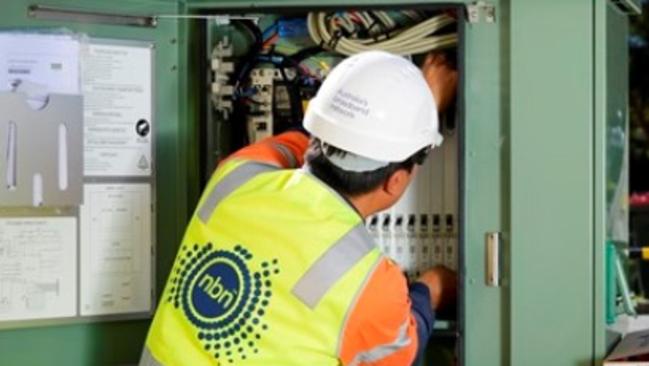
The National Broadband Network got personal last week. I joined the 2.98 million households that have signed up to an “NBN” plan only to find the service appalling.
Not being much of a “web surfer”, and erring on the frugal side, I went for the $50-a-month “hassle-free” plan from Belong, an internet service provider owned by Telstra.
“Hassle-free” is not quite accurate. Yesterday the download speed was 6.5Mbps (about half the advertised “up to 12Mbps”). That’s the average achieved by Turkey, Chile and Mexico four years ago, when the average in Japan and Switzerland was 15Mbps. And that’s when it works.
“You won’t ever run out of data or be charged extra for top-ups,” Belong enthuses in its advertising. Well, that’s true, because it’s impossible to download much. Luckily for Telstra, I’ve had to buy a laptop dongle to access the internet when Belong conks out.
Since then I’ve discovered that for an extra $10 a month, I can “crank it up” to 15Mbps. “Watch more shows online with minimal buffering.” Excuse me, “minimal buffering”? The government has spent $29.5 billion on the NBN and the best we can expect is “minimal buffering” on a premium plan? It’s clear the NBN isn’t providing anything remotely like the “fast, affordable broadband to all Australians” the government boasts in its budget. What’s going on?
It turns out patchy slow speeds, even in the heart of our biggest cities, aren’t NBN’s fault directly. Labor’s initial 2009 plan to build fibre to every premise in the country was unrealistic. The initial rollout, which began in Tasmania, saw NBN paying up to $90,000 to build fibre to a single house. The Abbott government was right to scale back such ambition, finding in 2013 that Labor’s plan would have cost north of $72bn.
A mix of fibre, copper and satellites is adequate to provide internet speeds fast enough for what the bulk of households might want — the question is how to pay for even those speeds.
Because the government insists NBN operate on commercial terms, NBN has to charge internet service providers a CVC (connectivity virtual circuit) charge, which varies according to how much bandwidth they want. Bandwidth governs how much data can flow to the ISPs’ customers at any given time, which means at peak periods ISPs that have been stingy with bandwidth can’t provide high speeds.
It turns out Belong — perhaps Exclude would be a better brand name — doesn’t buy very much bandwidth compared with ISPs such as TPG and Aussie Broadband.
Caveat emptor? Well, it would have been nice to know upfront the relationship between an ISP’s capacity and its number of customers, or perhaps the average speed it is providing. Free markets only work if buyers are fully and clearly informed about price and quality. The Australian Competition & Consumer Commission is at least investigating how ISPs advertise.
In any case, there’s a massive turf war among ISPs to sign up as many households as possible. They are competing on price, not quality. Business knows the power of inertia: disgruntled users are unlikely to switch providers once they sign, especially if doing so incurs extra charges.
The CVC charge provided NBN about $300 million of revenue last financial year, 30 per cent of the total. Without it, ISPs could offer at least fast broadband at realistic prices 24 hours a day, which would fulfil what the government has promised.
Running the NBN on commercial terms is proving ridiculous, like trying to build the pyramids at a profit. Quite simply, most people never wanted incredibly fast broadband and won’t pay for it. “The best overseas comparison is Canada,” says Gary McLaren, former chief technology officer at NBN. “Similar geography, similar population, similar economy. No natural monopoly provider and only a small subsidy for regional areas. It has also rates significantly better than Australia on broadband benchmarks.”
Sooner or later the government will have to bring the NBN on its balance sheet and acknowledge the fiscal debacle. The agreed rate of return of the NBN has already been marked down from 7.1 per cent to 3.3 per cent to as low as 2.7 per cent last year — barely more than the government 10-year bond rate. In the most recent budget, the government said it had “provided a loan on commercial terms” of $19.5bn. If it was on commercial terms, then why did the government have to provide it?
NBN has already sapped the government’s net worth by almost $8.8bn, according to a Parliamentary Budget Office analysis last year. That’s going to get worse on present trends: only half of households with access to NBN have taken it up so far. And once word spreads how poor the service is for $60 a month, few will want it.
Naturally, being honest would blow plans for a budget surplus in 2021, as $49bn of public money (the government’s total exposure so far) would need to be marked down. But at least a rational analysis of how to make the most of the costly infrastructure that is being built could begin. Should it stay in government ownership and be run at cost, or at a loss? The risk is the government is creating another privatised monopoly, NBN Co, to replace Telstra. (Or perhaps Telstra will buy NBN?)
As the PBO said, the value of the NBN will be what the government can sell it for after 2020, when the rollout is meant to have been completed. That means it will have to fatten up the NBN calf so it can sell it for a sum that justifies the immense public investment. It will probably do this by making regulations that ensure NBN, and whoever buys it, is subject to little genuine competition.
It seems the consumer will be gouged relentlessly by someone, whether it’s government or a private monopoly. Given the folly of the original decision, the question for policy is how to minimise the gouging.




To join the conversation, please log in. Don't have an account? Register
Join the conversation, you are commenting as Logout